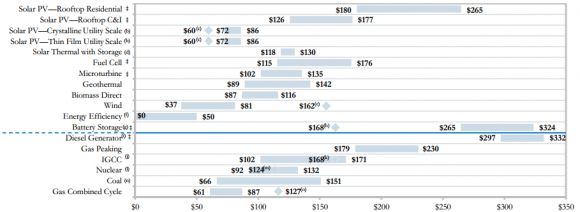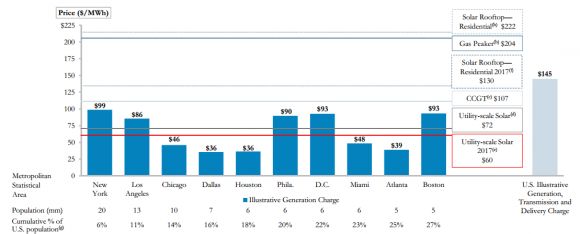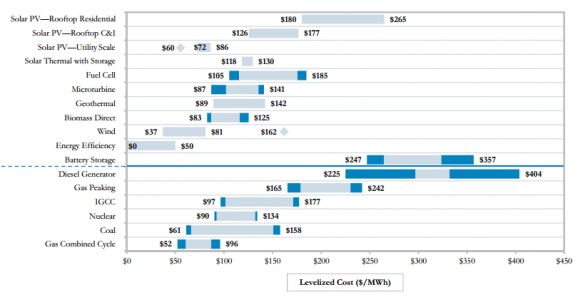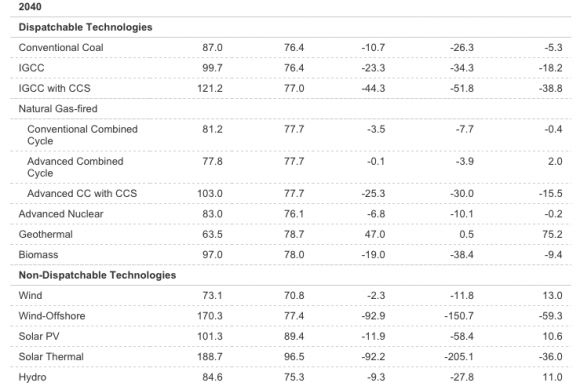Renewables in the electricity sector are undoubtedly getting cheaper. But exactly how cheap compared to conventional fuels?
If using the common levelized cost of energy (LCOE) metric, renewables are actually starting to rival fossil fuels and nuclear on an unsubsidized basis, according to the latest calculations from the financial advisory firm Lazard.
In the newest version of its comprehensive LCOE analysis of energy technologies, Lazard finds that a wide variety of renewables are, in some cases, directly competitive with coal, gas and nuclear without federal tax support.
LCOE is the megawatt-hour cost of a particular technology in real dollars. The calculation, which factors in capital expenditures, dispatchability, fuel costs, operations and maintenance costs, and financing costs, is a widely used metric for comparing different energy resources.
Lazard’s research shows that the average cost of biomass, geothermal, onshore wind and utility-scale solar all compete with -- or even beat -- natural-gas peaking plants, natural-gas combined cycle plants, coal plants and nuclear plants. Energy efficiency, by far the lowest-cost resource, beats everything handily.
“Over the last five years, wind and solar PV have become increasingly cost-competitive with conventional generation technologies, on an unsubsidized basis,” concludes Lazard.
Click the chart to expand.
There are inherent limitations to using LCOE to compare different technologies, as it doesn’t account for many real-world usage considerations. Lazard's analysis does not include capacity values, stranded costs, integration costs, environmental costs or waste disposal costs. These factors potentially change the value of renewables, fossil fuels and nuclear.
For example, as the chart below shows, Lazard finds that utility-scale solar can be far more cost-effective than natural-gas peaking plants. In the U.S., some contracts for utility-scale plants are coming in well below the low-end averages outlined in the study.
However, without integrating storage, “solar lacks the dispatch characteristics of conventional peaking technologies,” writes Lazard.
Click the chart to expand.
The solar-storage combination is not analyzed in the study, although the unsubsidized cost of battery storage is one of the second-most expensive technologies behind diesel generators, according to the analysis. One could make a similar argument about the long-term environmental and societal costs of fossil fuels, but Lazard calls these “difficult to measure” due to widely varying estimates.
The cost profiles of renewables and fossil fuels are very different. Coal and natural gas plants have lower upfront capital costs, but are sensitive to fuel prices; technologies like wind, solar and geothermal have no fuel costs, but are far more capital-intensive to build upfront, making them sensitive to financing costs. The chart below shows how fuel prices can impact the economics of certain technologies.
Click the chart to expand.
The upfront equipment, financing and labor costs for renewables continue to improve. The Lazard analysis shows how this has influenced solar PV, which has seen a 78 percent decrease in LCOE over the last five years, averaged across the utility-scale, commercial/industrial and distributed rooftop sectors.
“Rooftop solar has benefited from the rapid decline in price of both panels and key balance-of-system components (e.g., inverters, racking, etc.); while the small-scale nature and added complexity of rooftop installation limit cost reduction levels (vs. levels observed in utility-scale applications), more efficient installation techniques, lower costs of capital and improved supply chains will contribute to a lower rooftop solar LCOE over time,” writes Lazard.

The Lazard study shows a clear improvement in the competitiveness of renewables, even on an unsubsidized basis. However, LCOE is only one way to look at the actual cost of various technologies.
The Energy Information Administration (EIA) identified the limitations of LCOE in a recent update to its cost analysis of energy technologies.
"It is important to note that, while LCOE is a convenient summary measure of the overall competitiveness of different generating technologies, actual plant investment decisions are affected by the specific technological and regional characteristics of a project, which involve numerous other factors," explains EIA.
A more helpful metric for making specific project-level decisions is the levelized avoided cost of electricity (LACE), which compares the marginal cost and average annual output of a new power plant with the cost of existing generation assets. By comparing LACE to LCOE, one can get a more accurate picture of the value of a particular resource to the grid.
“When the LACE of a particular technology exceeds its LCOE at a given time and place, that technology would generally be economically attractive to build,” writes EIA. In other words, if the difference between LACE and LCOE is negative, the power plant has less value to the grid; if it’s positive, it has more value.
Using this comparison, EIA shows that, on average, nuclear and dispatchable natural gas plants offer more value to the grid than nondispatchable renewables, except geothermal and hydro through 2019. However, through 2040, onshore wind, solar PV, geothermal and hydro all show a net benefit to the grid that is potentially greater than combined-cycle gas plants in regions with high resource availability -- reflecting increases in natural gas prices that offset capital cost improvements.
Click the chart to expand.
There are many variables for determining the local value of renewables versus fossil fuels or nuclear. LCOE or LACE analyses do not necessarily offer a full accounting of project performance. But they do provide a helpful guide on where the cost of renewables is headed -- and that’s continually downward.






